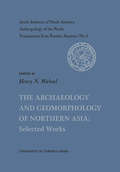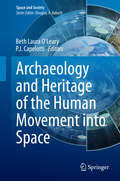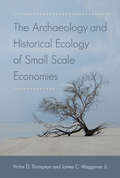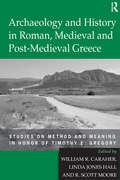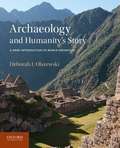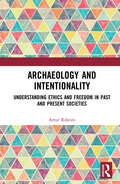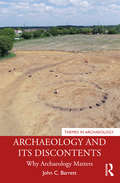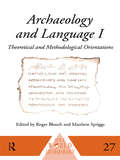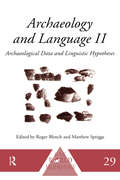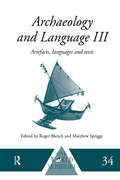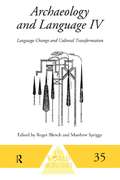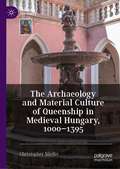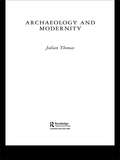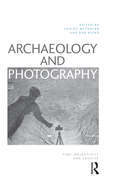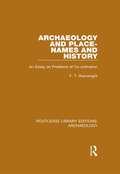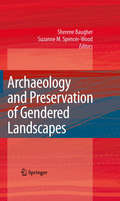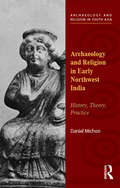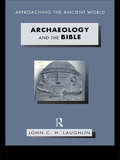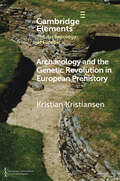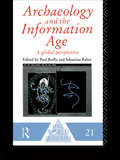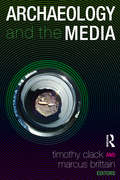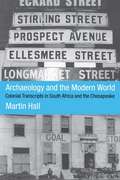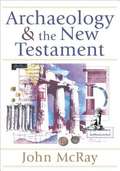- Table View
- List View
The Archaeology and Geomorphology of Northern Asia: Selected Works (Arctic Institute of North America Anthropology of the North #No. 5)
by Henry N. MichaelThe eighteen articles appearing in this, the fifth, number of Anthropology of the North: Translations from Russian Sources, were mostly published between the years 1957 and 1963. The exceptions are S.I. Rudenko's "The culture of the prehistoric population of Kamchatka," published in 1948, and A.P. Okladnikov's "Paleolithic remains in the Lena river basin," published in 1953. Thirteen of the articles deal with the archaeology and five with the geomorphology of selected areas of northern Asia. Dr. Chester S. Chard of the University of Wisconsin analyzes the contents and meaning of these articles in his Introduction to the book and fruitfully correlates them with other sources which have been made available to the English-reading specialist over the past few years. In the Notes and References attached to each article, editorial reference has sometimes been added about the availability in English translation of a cited article.
Archaeology and Heritage of the Human Movement into Space (Space and Society)
by Beth Laura O'Leary P. J. CapelottiThis volume addresses the creation, documentation, preservation, and study of the archaeology of lunar, planetary, and interstellar exploration. It defines the attributes of common human technological expressions within national and, increasingly, private exploration efforts, and explore the archaeology of both fixed and mobile artifacts in the solar system and the wider galaxy. This book presents the research of the foremost scholars in the field of space archaeology and heritage, a recent discipline of the field of Space Archaeology and Heritage. It provides the emerging archaeological perspective on the history of the human exploration of space. Since humans have been creating a vast archaeological preserve in space and on other celestial bodies. This assemblage of heritage objects and sites attest to the human presence off the Earth and the study of these material remains are best investigated by archaeologists and historic preservationists. As space exploration has reached the half century mark, it is the appropriate time to reflect on the major events and technological development of this particular unique 20th century arena of human history. The authors encapsulate various ways of looking at the archaeology of both fixed and mobile human artifacts in the solar system. As missions continue into space, and as private ventures gear up for public and tourist visits to space and to the Moon and even Mars, it is the appropriate time to address questions about the meaning and significance of this material culture.
The Archaeology and Historical Ecology of Small Scale Economies
by Victor D. Thompson James C. WaggonerMost research into humans' impact on the environment has focused on large-scale societies; a corollary assumption has been that small scale economies are sustainable and in harmony with nature. The contributors to this volume challenge this notion, revealing how such communities shaped their environment—and not always in a positive way. Offering case studies from around the world—from Brazil to Japan, Denmark to the Rocky Mountains—the chapters empirically demonstrate the substantial transformations of the surrounding landscape made by hunter-gatherer and limited horticultural societies. Summarizing previous research as well as presenting new data, this book shows that the environmental impact and legacy of societies are not always proportional their size. Understanding that our species leaves a footprint wherever it has been leads to both a better understanding of our prehistoric past and to deeper implications for our future relationship to the world around us.
Archaeology and History in Roman, Medieval and Post-Medieval Greece: Studies on Method and Meaning in Honor of Timothy E. Gregory
by Linda Jones HallThe essays in Archaeology and History in Roman, Medieval and Post-Medieval Greece honor the contributions of Timothy E. Gregory to our understanding of Greece from the Roman period to modern times. Evoking Gregory's diverse interests, the volume brings together anthropologists, art historians, archaeologists, historians, and philologists to address such contested topics as the end of Antiquity, the so-called Byzantine Dark Ages, the contours of the emerging Byzantine civilization, and identity in post-Medieval Greece. These papers demonstrate the continued vitality of both traditional and innovative approaches to the study of material culture and emphasise that historical interpretation should be the product of methodological self-awareness. In particular, this volume shows how the study of the material culture of post-Classical Greece over the last 30 years has made significant contributions to both the larger archaeological and historical discourse. The essays in this volume are organized under three headings - Archaeology and Method, the Archaeology of Identity, and the Changing Landscape - which highlight three main focuses of Gregory's research. Each essay interlaces new analyses with the contributions Gregory has made to our understanding of Medieval and Post-Medieval Greece. Read together these essays not only make a significant contribution to how we understand the post-Classical Greek world, but also to how we study the material culture of the Mediterranean world more broadly.
The Archaeology and History of Colonial Mexico
by Enrique Rodríguez-AlegríaThis is an archaeological and historical study of Mexico City and Xaltocan, focusing on the early years after the Spanish conquest of the Aztec empire in 1521. The study of households excavated in Mexico City and the probate inventories of 39 colonizers provide a vivid view of the material and social lives of the Spanish in what was once the capital of the Aztec empire. Decades of archaeological and ethnohistorical research in Xaltocan, a town north of Mexico City, offers a long-term perspective of daily life, technology, the economy, and the adoption of Spanish material culture among indigenous people. Through these case studies, this book examines interpretive strategies used when working with historical documents and archaeological data. Focusing on the use of metaphors to guide interpretation, this volume explores the possibilities for interdisciplinary collaboration between historians, archaeologists, and anthropologists working on this pivotal period in Latin American history.
Archaeology and Humanity's Story: A Brief Introduction To World Prehistory
by Deborah I. OlszewskiThis student-friendly textbook introduces the archaeological past from approximately seven million years ago through later politically complex societies. Archaeology and Humanity's Story: A Brief Introduction to World Prehistory does not attempt to discuss every archaeologically important site and development in prehistory and early history. Rather, it presents key issues from earlier prehistory and then organizes the chapters on politically complex societies using a similar framework. This allows students to easily compare and contrast different geographical regions. Each of these chapters also highlights a specific case study in which similar themes are examined, such as the written word; resource networks, trade, and exchange; social life; ritual and religion; and warfare and violence. Each chapter includes several sidebar boxes, a timeline showing the chronology relevant to that chapter, and "The Big Picture," "Peopling the Past," and "Evolutionary Processes" features.
Archaeology and Intentionality: Understanding Ethics and Freedom in Past and Present Societies
by Artur RibeiroArchaeology and Intentionality explores perhaps one of the most overlooked topics in archaeology, that of intentionality. In archaeology, most explanations of human behaviour rely on intentionality, and this book fills a surprising gap in the literature. By identifying the historical trajectory of the notion of intentionality, this book reframes our understanding of what it means to act intentionally and how archaeologists provide explanations concerning past (and present) societies. In general, this book presents a strong framework for archaeological research, one that fits to current archaeological practices and research around the world. This framework considers that past actors were not unconditional free agents, who could act however they wished, nor were they absolute prisoners of the economic, biological, and environmental circumstances in which they lived. From the standpoint of intentionality, it becomes clear that human agency is not about what you can or cannot do, but about what you should do, that is to say, actions are above all ethical. In a world wealth inequality runs rampant, where humans have damaged the environment beyond recognition, and where technology advances at an alarming rate, it is important that we recognize our intentions and the ethical responsibility that accompanies those intentions. The book highlights how archaeology is the perfect discipline to understand how and from where those intentions come. Addressing several problems in archaeological theory and connecting archaeology, philosophy, and social theory, this book is for students and researchers interested in archaeological theory and how it informs practice.
Archaeology and its Discontents: Why Archaeology Matters (Themes in Archaeology Series)
by John C. BarrettArchaeology and its Discontents examines the state of archaeology today and its development throughout the twentieth century, making a powerful case for new approaches. Surveying the themes of twentieth-century archaeological theory, Barrett looks at their successes, limitations, and failures. Seeing more failures and limitations than successes, he argues that archaeology has over-focused on explaining the human construction of material variability and should instead be more concerned with understanding how human diversity has been constructed. Archaeology matters, he argues, precisely because of the insights it can offer into the development of human diversity. The analysis and argument are illustrated throughout by reference to the development of the European Neolithic. Arguing both for new approaches and for the importance of archaeology as a discipline, Archaeology and its Discontents is for archaeologists at all levels, from student to professor and trainee to experienced practitioner.
Archaeology and Language I: Theoretical and Methodological Orientations (One World Archaeology #Vol. 27)
by Roger Blench Matthew SpriggsArchaeology and Language I represents groundbreaking work in synthesizing two disciplines that are now seen as interlinked: linguistics and archaeology. This volume is the first of a three-part survey of innovative results emerging from their combination. Archaeology and historical linguistics have largely pursued separate tracks until recently, although their goals can be very similar. While there is a new awareness that these disciplines can be used to complement one another, both rigorous methodological awareness and detailed case-studies are still lacking in literature. Archaeology and Language I aims to fill this lacuna. Exploring a wide range of techniques developed by specialists in each discipline, this first volume deals with broad theoretical and methodological issues and provides an indispensable background to the detail of the studies presented in volumes II and III. This collection deals with the controversial question of the origin of language, the validity of deep-level reconstruction, the sociolinguistic modelling of prehistory and the use and value of oral tradition.
Archaeology and Language II: Archaeological Data and Linguistic Hypotheses (One World Archaeology)
by Roger Blench Matthew SpriggsUsing language to date the origin and spread of food production, Archaeology and Language II represents groundbreaking work in synthesizing two disciplines that are now seen as interlinked: linguistics and archaeology. This volume is the second part of a three-part survey of innovative results emerging from their combination. Archaeology and historical linguistics have largely pursued separate tracks until recently, although their goals can be very similar. While there is a new awareness that these disciplines can be used to complement one another, both rigorous methodological awareness and detailed case-studies are still lacking in the literature. This three-part survey is the first study to address this. Archaeology and Language II examines in some detail how archaeological data can be interpreted through linguistic hypotheses. This collection demonstrates the possibility that, where archaeological sequences are reasonably well-known, they might be tied into evidence of language diversification and thus produce absolute chronologies. Where there is evidence for migrations and expansions these can be explored through both disciplines to produce a richer interpretation of prehistory. An important part of this is the origin and spread of food production which can be modelled through the spread of both plants and words for them. Archaeology and Language II will be of interest to researchers in linguistics, archaeologists and anthropologists.
Archaeology and Language III: Artefacts, Languages and Texts (One World Archaeology)
by Roger Blench Matthew SpriggsArchaeology and Language III interprets results from archaeological data in terms of language distribution and change, providing the tools for a radical rewriting of the conventional discourse of prehistory. Individual chapters present case studies of artefacts and fragmentary textual materials, concerned with the reconstruction of houses, maritime technology, pottery and grave goods.
Archaeology and Language IV: Language Change and Cultural Transformation (One World Archaeology #Vol. 35)
by Roger Blench Matthew SpriggsArchaeology and Language IV examines a variety of pressing issues regarding linguistic and cultural change. It provides a challenging variety of case-studies which demonstrate how global patterns of language distribution and change can be interwoven to produce a rich historical narrative, and fuel a radical rethinking of the conventional discourse of linguistics within archaeology.
The Archaeology and Material Culture of Queenship in Medieval Hungary, 1000–1395 (Queenship and Power)
by Christopher MielkeThis book explores an alternate history of the power and agency of 30 Hungarian queens over 400 years by a rigorous examination of the material culture connected with their lives. By researching the objects, images, and spaces, it demonstrates how these women expressed and displayed their power. Queens used material culture and space not only to demonstrate their own power to a wide, international audience, but also to consolidate their own position when it was weakened by external circumstances. Both the public and private image of the queen factors significantly in understanding in her own role at the strongly centralized Hungarian court, and, moreover, how her position and person strengthened and complemented that of the king.
Archaeology and Modernity
by Julian ThomasThis is the first book-length study to explore the relationship between archaeology and modern thought, showing how philosophical ideas that developed in the seventeenth to nineteenth centuries still dominate our approach to the material remains of ancient societies. Addressing current debates from a new viewpoint, Archaeology and Modernity discusses the modern emphasis on method rather than ethics or meaning, our understanding of change in history and nature, the role of the nation-state in forming our views of the past, and contemporary notions of human individuality, the mind, and materiality.
Archaeology and Photography: Time, Objectivity and Archive
by Lesley McFADYENDoes a photograph freeze a moment of time? What does it mean to treat a photographic image as an artefact? In the visual culture of the 21st century, do new digital and social forms change the status of photography as archival or objective – or are they revealing something more fundamental about photography’s longstanding relationships with time and knowledge?Archaeology and Photography imagines a new kind of Visual Archaeology that tackles these questions. The book reassesses the central place of Photography as an archaeological method, and re-wires our cross-disciplinary conceptions of time, objectivity and archives, from the History of Art to the History of Science.Through twelve new wide-ranging and challenging studies from an emerging generation of archaeological thinkers, Archaeology and Photography introduces new approaches to historical photographs in museums and to contemporaryphotographic practice in the field. The book re-frames the relationship between Photography and Archaeology, past and present, as more than a metaphor or an analogy – but a shared vision.Archaeology and Photography calls for a change in how we think about photography and time. It argues that new archaeological accounts of duration and presence can replace older conceptions of the photograph as a snapshot orremnant received in the present. The book challenges us to imagine Photography, like Archaeology, not as a representation of the past and the reception of traces in the present but as an ongoing transformation of objectivity and archive.Archaeology and Photography will prove indispensable to students, researchers and practitioners in History, Photography, Art, Archaeology, Anthropology, Science and Technology Studies and Museum and Heritage Studies.
Archaeology and Place-Names and History: An Essay on Problems of Co-ordination (Routledge Library Editions: Archaeology)
by F.T. WainwrightIn the period A.D. 400-1100, perhaps more than in any other, it is necessary to bring together the results of historical, archaeological and place-name studies. Each provides information that is either badly preserved or not preserved at all in the other two, but it is not always realised how great are the difficulties involves in co-ordination and integration. This book, originally published in 1962, draws attention to the problems and provides a basis for discussion.
Archaeology and Preservation of Gendered Landscapes
by Suzanne M. Spencer-Wood Sherene BaugherHistorical archaeology of landscapes initially followed the pattern of Classical Archaeology by studying elite men's gardens. Over time, particularly in North America, the field has expanded to cover larger settlement areas, but still often with ungendered and elite focus. The editors of this volume seek to fill this important gap in the literature by presenting studies of gendered power dynamics and their effect on minority groups in North America. Case studies presented include communities of Native Americans, African Americans, multi-ethnic groups, religious communities, and industrial communities. Just as the research focus has previously neglected the groups presented here, so too has funding to preserve important archaeological sites. As the contributors to this important volume present a new framework for understanding the archaeology of religious and social minority groups, they also demonstrate the importance of preserving the cultural landscapes, particularly of minority groups, from destruction by the modern dominant culture. A full and complete picture of cultural preservation has to include all of the groups that interacted form it.
Archaeology and Religion in Early Northwest India: History, Theory, Practice (Archaeology and Religion in South Asia)
by Daniel MichonThis book explores the ways in which past cultures have been used to shape colonial and postcolonial cultural identities. It provides a theoretical framework to understand these processes, and offers illustrative case studies in which the agency of ancient peoples, rather than the desires of antiquarians and archaeologists, is brought to the fore.
Archaeology and the Bible (Approaching the Ancient World)
by John LaughlinThis book challenges readers to consider whether archaeology explains the Bible.Archaeology and the Bible examines new developments in archaeological finds in the Near East, particularly Palestine, that are related to the Bible. New methodologies, regional surveys and creative syntheses have all had an impact on traditional approaches to looking at these discoveries. John Laughlin examines these new developments and discusses what they imply for biblical studies.
Archaeology and the Genetic Revolution in European Prehistory (Elements in the Archaeology of Europe)
by Kristian KristiansenThis Element was written to meet the theoretical and methodological challenge raised by the third science revolution and its implications for how to study and interpret European prehistory. The first section is therefore devoted to a historical and theoretical discussion of how to practice interdisciplinarity in this new age, and following from that, how to define some crucial, but undertheorized categories, such as culture, ethnicity and various forms of migration. The author thus integrates the new results from archaeogenetics into an archaeological frame of reference, to produce a new and theoretically informed historical narrative, one that also invites debate, but also one that identifies areas of uncertainty, where more research is needed.
Archaeology and the Information Age (One World Archaeology)
by Paul Reilly Sebastian RahtzTraditional methods of making archaeological data available are becoming increasingly inadequate. Thanks to improved techniques for examining data from multiple viewpoints, archaeologists are now in a position to record different kinds of data, and to explore that data more fully than ever before. The growing availablility of computer networks and other technologies means that communication should become increasingly available to international archaeologists. Will this result in the democratisation of archaeological knowledge on a global basis? Contributors from Western and Eastern Europe, the Far East, Africa and the Americas seek to answer this and other questions about the way in which modern technology is revolutionising archaeological knowledge.
Archaeology and the Media (UCL Institute of Archaeology Publications)
by Timothy Clack Marcus BrittainThe public’s fascination with archaeology has meant that archaeologists have had to deal with media more regularly than other scholarly disciplines. How archaeologists communicate their research to the public through the media and how the media view archaeologists has become an important feature in the contemporary world of academic and professional archaeologists. In this volume, a group of archaeologists, many with media backgrounds, address the wide range of questions in this intersection of fields. An array of media forms are covered including television, film, photography, the popular press, art, video games, radio and digital media with a focus on the overriding question: What are the long-term implications of the increasing exposure through and reliance upon media forms for archaeology in the contemporary world? The volume will be of interest to archaeologists and those teaching public archaeology courses.
Archaeology and the Modern World: Colonial Transcripts in South Africa and Chesapeake
by Martin HallArchaeology and the Modern World advances a new controversial theory of historical archaeology. Using new case studies, Martin Hall evaluates the major theoretical traditions in historical archaeology while contributing significantly to the debate. In this study the author places an emphasis on material culture and the recent past to bring to light a picture of an unstable and violent early colonial world in which material culture played a crucial mediating role.
Archaeology and the New Testament
by John McRayAs he tours sites associated with the ministry of Jesus, the journey of Paul, and the seven churches of Revelation, he shows the pervasive influence of society, architecture, and religion on the peoples of the first century and on the New Testament.
Archaeology and the Senses
by Yannis HamilakisThis book is an exciting new look at how archaeology has dealt with the bodily senses and offers an argument for how the discipline can offer a richer glimpse into the human sensory experience. Yannis Hamilakis shows how, despite its intensely physical engagement with the material traces of the past, archaeology has mostly neglected multi-sensory experience, instead prioritizing isolated vision and relying on the Western hierarchy of the five senses. In place of this limited view of experience, Hamilakis proposes a sensorial archaeology that can unearth the lost, suppressed, and forgotten sensory and affective modalities of humans. Using Bronze Age Crete as a case study, Hamilakis shows how sensorial memory can help us rethink questions ranging from the production of ancestral heritage to large-scale social change, and the cultural significance of monuments. Tracing the emergence of palaces in Bronze Age Crete as a celebration of the long-term, sensuous history and memory of their localities, Hamilakis points the way to reconstituting archaeology as a sensorial and affective multi-temporal practice. At the same time, he proposes a new framework on the interaction between bodily senses, things, and environments, which will be relevant to scholars in other fields.
